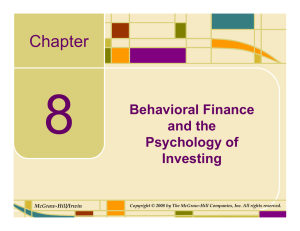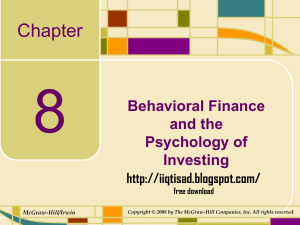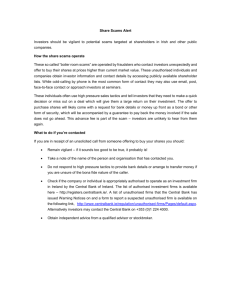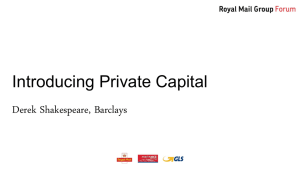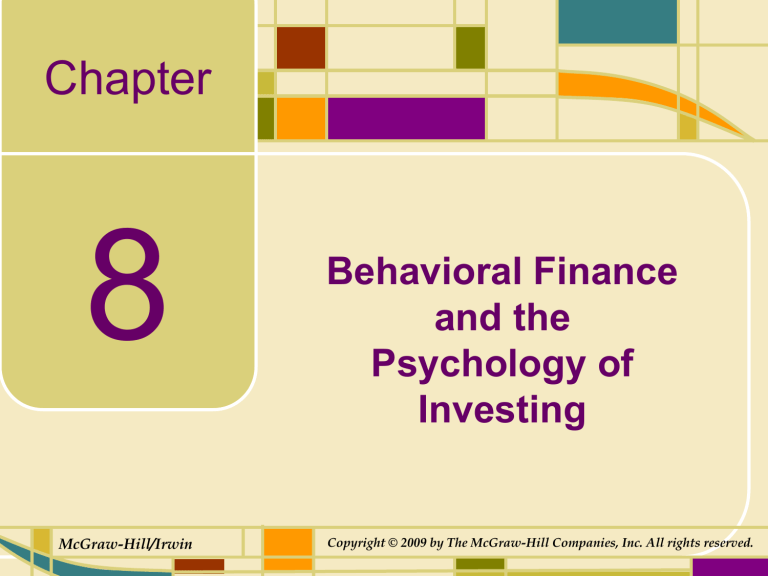
Chapter
8
McGraw-Hill/Irwin
Behavioral Finance
and the
Psychology of
Investing
Copyright © 2009 by The McGraw-Hill Companies, Inc. All rights reserved.
“The investor’s chief problem, and even his worst
enemy, is likely to be himself.”
— Benjamin Graham
“There are three factors that influence the market:
Fear, Greed, and Greed.”
— Market folklore
8-2
Learning Objectives
Psych yourself up and get a
good understanding of:
1. Prospect theory.
2. The implications of investor overconfidence and
misperceptions of randomness.
3. Sentiment-based risk and limits to arbitrage.
4. The wide array of technical analysis methods used
by investors.
8-3
Behavioral Finance, Introduction
• Sooner or later, you are going to make an investment decision that
winds up costing you a lot of money.
•
Why is this going to happen?
– You made a sound decision, but you are “unlucky.”
– You made a bad decision—one that could have been avoided.
• The beginning of investment wisdom:
– Learn to recognize circumstances leading to poor decisions.
– Then, you will reduce the damage from investment blunders.
8-4
Behavioral Finance, Definition
• Behavioral Finance The area of research that attempts to
understand and explain how reasoning errors influence investor
decisions and market prices.
• Much of behavioral finance research stems from the research in the
area of cognitive psychology.
– Cognitive psychology: the study of how people (including investors)
think, reason, and make decisions.
– Reasoning errors are often called cognitive errors.
• Some people believe that cognitive (reasoning) errors made by
investors will cause market inefficiencies.
8-5
Three Economic Conditions that
Lead to Market Efficiency
1) Investor rationality
2) Independent deviations from rationality
3) Arbitrage
•
For a market to be inefficient, all three conditions must be absent.
That is,
– it must be that many, many investors make irrational investment
decisions, and
– the collective irrationality of these investors leads to an overly optimistic
or pessimistic market situation, and
– this situation cannot be corrected via arbitrage by rational, wellcapitalized investors.
•
Whether these conditions can all be absent is the subject of a raging
debate among financial market researchers.
8-6
Prospect Theory
•
Prospect theory provides an alternative to classical, rational
economic decision-making.
•
The foundation of prospect theory: investors are much more
distressed by prospective losses than they are happy about
prospective gains.
–
–
–
Researchers have found that a typical investor considers the pain of a $1 loss to
be about twice as great as the pleasure received from the gain of $1.
Also, researchers have found that investors respond in different ways to
identical situations.
The difference depends on whether the situation is presented in terms of losses
or in terms of gains.
8-7
Investor Behavior Consistent
with Prospect Theory Predictions
•
There are three major judgment errors consistent with the
predictions of prospect theory.
– Frame Dependence
– Mental Accounting
– The House Money Effect
•
There are other judgment errors that are also consistent with the
predictions of prospect theory.
8-8
Frame Dependence, I.
• If an investment problem is presented in two different (but really
equivalent) ways, investors often make inconsistent choices.
• That is, how a problem is described, or framed, seems to matter to
people.
• Some people believe that frames are transparent. Are they?
• Try this: Jot down your answers in the following two scenarios.
8-9
Frame Dependence, II.
• Scenario One. Suppose we give you $1,000.
Then, you have the following choice to make:
A. You can receive another $500 for sure.
B. You can flip a fair coin. If the coin-flip comes up “heads,” you get
another $1,000, but if it comes up “tails,” you get nothing.
• Scenario Two. Suppose we give you $2,000.
Then, you have the following choice to make:
A. You can lose $500 for sure.
B. You can flip a fair coin. If the coin-flip comes up “heads,” you lose
another $1,000, but if it comes up “tails,” you lose nothing.
8-10
Frame Dependence, III.
• What were your answers?
• Did you: choose option A in the first scenario
and choose option B in the second scenario?
– If you did, you are guilty of focusing on gains and losses, and not paying
attention to what is important—the impact on your wealth.
– However, you are not alone.
• About 85 percent of the people who are presented with the first scenario
choose option A.
• About 70 percent of the people who are presented with the second scenario
choose option B.
8-11
Frame Dependence, IV.
• But, the two scenarios are actually identical.
• In each scenario:
– You end up with $1,500 for sure if you pick option A.
– You end up with a 50-50 chance of either $1,000 or $2,000 if you pick
option B.
– So, you should pick the same option in both scenarios.
• Which option you prefer is up to you.
• But, if you are focusing on wealth, you should never pick option A in
one scenario and option B in the other.
• The reason people do is that the phrasing, or framing, of the
question causes people to answer the questions differently.
8-12
Mental Accounting and Loss Aversion
•
Mental Accounting: Associating a stock with its purchase price.
•
If you are engaging in mental accounting:
– You find it is difficult to sell a stock at a price lower than your purchase price.
– If you sell a stock at a loss:
• It may be hard for you to think that purchasing the stock in the first place was correct.
• You may feel this way even if the decision to buy was actually a very good decision.
– A further complication of mental accounting is loss aversion.
•
Loss Aversion: A reluctance to sell investments after they have fallen in
value. Also known as the “breakeven” effect or “disposition” effect.
•
If you suffer from Loss Aversion, you will think that if you can just somehow
“get even,” you will be able to sell the stock.
•
If you suffer from Loss Aversion, it is sometimes said that you have “getevenitis.”
8-13
Do You Suffer from “Get-Evenitis?” Part I.
• Consider the following two investments:
Investment One. A year ago, you bought shares in Fama
Enterprises for $40 per share. Today, these shares are worth
$20 each.
Investment Two. A year ago, you bought shares in French
Company for $5 per share. Today, these shares are worth
$20 each.
• What will you do? Will you: (1) sell one of these stocks; (2) sell both
of these stocks; (3) hold one of these stocks; or, (4) hold both of
these stocks?
8-14
Do You Suffer from “Get-Evenitis?” Part II.
• Suppose you are considering a new investment in Fama
Enterprises.
• Does your rational analysis say that it is reasonable to purchase
shares at $20?
– If the rational answer is no, then you should sell.
– If the rational answer is yes, then you do not suffer from loss
aversion.
• However, if you argued to yourself that if shares in Fama Enterprises
were a good buy at $40, then they must be a steal at $20, you
probably have a raging case of loss aversion.
8-15
Do You Suffer from “Get-Evenitis?” Part III.
• There are Two Important Lessons from this Example.
– Lesson One: The market says that shares in Fama Enterprises are
worth $20. The market does not care that you paid $40 a year ago.
– Lesson Two: You should not care about your purchase price of Fama
Enterprises. You must evaluate your shares at their current price.
• How about the shares in French Company?
– Once again, the lessons are the same.
– The market says that French Company shares are worth $20 today.
– The fact that you paid $5 a year ago is not relevant.
• Get-Evenitis can be destructive. Famous example: Nicholas Leeson
causing the collapse of the 233-year-old Barings Bank.
Note Bene: For both investments, there will be tax effects. Your careful
analysis should acknowledge the existence of taxes and transaction fees,
and their impact on your net sale proceeds.
8-16
The House Money Effect, I.
•
Las Vegas casinos have found that gamblers are far more likely to take big
risks with money that they have won from the casino (i.e., “house money”).
•
Also, casinos have found that gamblers are not as upset about losing house
money as they are about losing their own gambling money.
•
It may seem natural for you to separate your money into two buckets:
– Your very precious money earned through hard work, sweat, and sacrifice.
– Your less precious windfall money (i.e., house money).
•
But, this separation is plainly irrational.
– Any dollar you have buys the same amount of goods and services.
– The buying power is the same for “your money” and for your “house money.”
8-17
The House Money Effect, II.
• Let us return to the shares of Fama Enterprises and French
Company.
• Suppose shares in both were to decline to $15.
• You might feel very differently about the decline depending on
which stock you looked at.
– With Fama Enterprises, the decline makes a bad situation even worse.
Now you are down $25 per share on your investment.
– On the other hand, with French Company, you only “give back” some of
your “paper profit.” You are still way ahead.
8-18
The House Money Effect, III.
• Thinking this way means that you are guilty of playing with house
money.
• Whether you lose money from your original investment or lose
money from your investment gains is irrelevant.
• There are two important investment lessons here:
– Lesson One. There are no “paper profits.” Your profits are yours.
– Lesson Two. All your money is your money. You should not separate
your money into bundles labeled “my money” and “house money.”
8-19
Overconfidence: A Significant
Error in Investor Judgment
•
A serious error in judgment you can make as an investor is to be
overconfident.
•
We are all overconfident about our abilities in many areas.
•
Be honest: Do you think of yourself as a better than average driver?
– If you do, you are not alone.
– About 80 percent of the people who are asked this question will
say “yes.”
•
How does overconfidence affect investment decisions?
8-20
Overconfidence and Portfolio Diversification
•
Investors tend to invest too heavily in shares of the company for
which they work.
•
This loyalty can be very bad financially.
– Your earning power (income) depends on this company.
– Your retirement nest-egg also depends on this company.
•
Another examples of the lack of diversification is investing too
heavily in the stocks of local companies.
– Perhaps you know someone personally who works there.
– Perhaps you read about them in your local paper.
– Basically, you are unduly confident that you have a high degree of
knowledge about local companies.
8-21
Overconfidence and Trading Frequency, I.
•
If you are overconfident about your investment skill, it is likely that
you will trade too much.
•
Researchers have found that investors who make relatively more
trades have lower returns than investors who trade less frequently.
•
Researchers have found that the average household earned an
annual return of 16.4 percent.
•
Researchers have found that households that traded the most
earned an annual return of only 11.4 percent.
•
The moral is clear: Excessive trading is hazardous to your wealth.
8-22
Overconfidence and Trading Frequency, II.
Is Overtrading “a Guy Thing?”
•
Psychologists have found that men are more overconfident than
women in the area of finance. So,
–
–
Do men trade more than women?
Do portfolios of men under-perform the portfolios of women?
•
Researchers show that the answer to both questions is yes.
•
Men trade about 50 percent more than women.
•
Researchers show that both men and women reduce their portfolio
returns when they trade excessively.
–
–
•
The portfolio return for men is 94 basis points lower than portfolio returns for
women.
The portfolio return for single men is 144 basis points lower than the portfolio
return for single women.
Accounting for the effects of marital status, age, and income,
researchers also show that men invest in riskier positions.
8-23
Misperceiving Randomness
and Overreacting to Chance Events
• Cognitive psychologists have discovered that the human mind is a
pattern-seeking device.
• Humans conclude that there are causal factors or patterns at work
behind sequences of events even when the events are truly
random.
• The representativeness heuristic: Concluding that there are
causal factors at work behind random sequences. Or, if something
is random, it should look random.
• But, what does random look like?
8-24
A Coin Flipping Experiment
• Suppose we flip a coin twenty times and write down whether we get
a “head” or a “tail.”
• Then, we do it all over again. The results of our two sets of twenty
flips are:
– 1st Twenty: T T T H T T T H T T H H H T H H T H H H
– 2nd Twenty: T H T H H T T H T H T H T T H T H T H H
• Do these sequences of heads and tails both look random to you?
• Most people would say that the 1st Twenty and the 2nd Twenty
somehow look “different.”
– Both are random sequences.
– Both have ten heads and ten tails.
8-25
A Coin Flipping Experiment, Graphed
• Do you think the line labeled “1st Twenty” has a pattern to it, but the
line labeled “2nd Twenty” appears to be random?
• If so, your mind saw a pattern in a random sequence of coin flips.
8-26
The Hot-Hand Fallacy, I.
•
Suppose we look at the recent shooting by two basketball players
named LeBron and Shaquille.
•
Assume both of these players make half of their shots.
– LeBron: has just made two shots in a row.
– Shaquille: has just missed two shots in a row.
•
Researchers have found that if they ask basketball fans which
player has the better chance of making their next shot:
– 91 out of 100 will say LeBron.
– They say this because they think LeBron has a “hot-hand.”
•
But, researchers have found that the “hot hand” is an illusion.
– Players do not deviate much from their long-run shooting averages.
– However, fans, players, announcers, and coaches think that they do.
8-27
The Hot-Hand Fallacy, II.
•
Cognitive psychologists have studied the shooting percentage of one
NBA team for a season and found:
•
A detailed analysis of the shooting data reveals that, statistically
speaking, all shooting percentages in this table are the “same.”
•
It is true that basketball players shoot in streaks. But, these steaks
are within bounds for long-run shooting percentages.
8-28
The Hot-Hand Fallacy, III.
•
It is an illusion that basketball players are either “hot” or “cold.”
–
–
•
Clustering Illusion: Our human belief that random events that
occur in clusters are not really random.
–
–
•
If you believe in the “hot hand,” you will likely reject this fact because you “know
better” from watching shooters.
You are being fooled by randomness—randomness often appears in clusters.
Example: If a fair coin is flipped 20 times, there is about a 50 percent chance of
flipping four heads in a row.
If you flip four heads in a row, do you have a “hot hand” at coin flipping?
Mutual fund investing and the clustering illusion.
–
–
Every year, funds that have had exceptionally good performance receive large
inflows of money.
There is a universal disclaimer: “Past performance is no guarantee of future
results.” Nonetheless, investors chase past returns.
8-29
The Gambler’s Fallacy
•
Gambler’s Fallacy: Assuming that a departure for what occurs on
average will be corrected in the short run.
•
Another way to think about the gambler’s fallacy: because an event
has not happened recently, it has become “overdue” and is more
likely to occur.
•
Example: The odds on a US Roulette table never change.
– For each spin:
•
•
•
There is an 18 in 38 chance for a red number to “hit”
There is an 18 in 38 chance for a black number to “hit”
There is a 2 in 38 chance for a green number to “hit”
– You suffer from the Gambler’s Fallacy if you think that it is more likely
for a black number to “hit” after a series of red numbers have hit.
8-30
Sentiment-Based Risk and
Limits to Arbitrage, I.
•
The efficient markets hypothesis (EMH) does not require every
investor to be rational.
•
All that EMH requires is that there are at least some smart and wellfinanced investors.
– These investors are prepared to buy and sell to take advantage of any
mispricing in the marketplace.
– This activity is what keeps markets efficient.
•
Sometimes, however, a problem arises in this context.
•
Limits to Arbitrage: The notion that, under certain circumstances, it
may not possible for rational, well-capitalized traders to correct a
mispricing, at least not quickly.
8-31
Sentiment-Based Risk and
Limits to Arbitrage, II.
• Strategies designed to eliminate mispricings are often
risky, costly, or restricted. Three important problems are:
•
Firm-Specific Risk (the most obvious risk).
– Suppose you believe that GM’s stock price is too low, so you buy.
– Then, some unanticipated bad news drives GM’s stock price lower.
•
Noise Trader Risk (also known as sentiment-based risk)
– Noise Trader: Someone whose trades are not based on information or
financially meaningful analysis.
– Noise traders could act “together” to worsen a mis-pricing.
– Noise trader risk is important because the worsening of a mis-pricing
could force the arbitrageur to liquidate early (and sustain steep losses).
– If noise trader risk exists, then this risk is another source of risk beyond
systematic risk and unsystematic risk.
8-32
Sentiment-Based Risk and
Limits to Arbitrage, III.
•
Implementation Costs: These costs include transaction costs such as
bid-ask spreads, brokerage commissions, and margin interest.
–
In addition, there might be some short-sale constraints.
•
•
–
One short-sale constraint arises when there are not enough shares to borrow.
This means the arbitrageur cannot take a large short position.
Another short-sale constraint stems from the legal restriction that many money
managers are not allowed to sell short.
•
•
pension fund managers
mutual fund managers
•
When firm specific risk, noise trader risk, or implementation costs are
present, a mispricing may persist because arbitrage is too risky or too
costly.
•
Collectively, these risks and costs create barriers, or limits, to arbitrage.
•
How important these limits are is difficult to say, but we do know that
mispricings occur, at least on occasion.
8-33
Sentiment-Based Risk and
Limits to Arbitrage, IV.
•
In 1907, Royal Dutch of the Netherlands and Shell of the UK agreed
to merge and split profits on a 60-40 basis.
•
So, if the stock prices of Royal Dutch and Shell are not in a 60-40
ratio, there is a potential arbitrage opportunity.
•
The next slide contains a plot of the daily deviations from the 60-40
ratio of the Royal Dutch price to the Shell price.
– If the prices are in a 60-40 ratio, there is no deviation.
– If there is a positive deviation, the price of Royal Dutch is too high.
– If there is a negative deviation, the price of Royal Dutch is too low.
•
As you can see, there have been large (and persistent) deviations
from the 60-40 ratio.
8-34
Sentiment-Based Risk and
Limits to Arbitrage, V.
8-35
Technical Analysis
• Many investors try to predict future stock price movements based on
investor sentiment, errors in judgment, and/or historical prices.
• These investors are using technical analysis.
• Technical analysis differs significantly from fundamental analysis.
• Unlike fundamental analysis, technical analysis does not rely on
traditional stock valuation techniques.
Technical analysts essentially search for
bullish (positive) and bearish (negative)
signals about stock prices or market direction.
8-36
Why Does Technical Analysis
Continue to Thrive?
• Proponents of the Efficient Markets Hypothesis do not believe that
technical analysis can help investors predict future stock prices.
• In this Internet and computer age, technical analysis is actually
thriving. Why?
• One possible reason: investors can derive thousands of successful
technical analysis systems by using historical security prices.
– Past security prices easily fit into a wide variety of technical systems.
– Technicians can continuously tinker and find methods that fit past prices.
– This process is known as “backtesting.” (But, investment success is all
about future prices.)
• Another possible reason: technical analysis simply sometimes works.
– Again, there are a large number of possible technical analysis systems.
– Many of them will appear to work in the short run.
8-37
The Market Sentiment Index, I.
• Market Sentiment The prevailing mood among investors about the
future outlook for an individual security or for the market.
– Market sentimentalists often believe that once 80% of the investors are
bullish or bearish, a “consensus” has been reached.
– Once a consensus is reached, market sentimentalists believe there is an
impending turn in the direction of the market.
– One way to measure market sentiment is to ask investors whether they
think the market is going up or down.
• 50 investors are asked whether they are “bullish” or “bearish” on the
market over the next month—20 say “bearish.”
• The Market Sentiment Index (MSI) can then be calculated as:
MSI
Number of Bearish Investors
Number of Bullish Investors Number of Bearish Investors
MSI
20
0.40.
30 20
8-38
The Market Sentiment Index, II.
• The MSI has a maximum value of 1.00, which occurs when every
investor you ask is bearish on the market.
•
The MSI has a minimum value of 0.00, which occurs when every
investor you ask is bullish on the market.
• This saying is handy when you are trying to remember how to use
the MSI: “When the MSI is high, it is time to buy; when the MSI
is low, it is time to go.”
• Note that there is not a theory to guide investors as to what level of
the MSI is “high,” and what level is “low.”
• This lack of precise guidance is a common problem with a technical
indicator like the MSI.
8-39
Dow Theory
• The Dow theory is a method that attempts to interpret and signal
changes in the stock market direction.
– Dates to turn of the 20th century.
– Named after Charles Dow (co-founder of the Dow Jones Co.)
• The Dow theory identifies three forces:
– a primary direction or trend,
– a secondary reaction or trend, and
– daily fluctuations.
(The Trend is your Friend…)
• Daily fluctuations are essentially noise and are of no real importance.
•
Dow Theory is less popular today, but its basic principles underlie
more contemporary approaches to technical analysis.
8-40
Elliott Waves
• Invented in the 1930’s by Ralph Nelson Elliott, A Dow Theorist.
• Mr. Elliott’s theory was that repeating stock price patterns, which he
called "waves," collectively expressed investor sentiment.
• Mr. Elliott believe that by using sophisticated "wave counting"
techniques, a wave theorist could forecast market turns accurately.
• The Elliott Wave Principle.
– There is a repeating eight wave sequence.
– The first five waves are “impulse” waves.
– The next three-waves are a “corrective” sequence.
• Still a widely-followed indicator.
8-41
Support and Resistance Levels
• A support level is a price or level below which a stock or the market
as a whole is unlikely to go.
• A resistance level is a price or level above which a stock or the
market as a whole is unlikely to rise.
• Support and resistance levels are “psychological barriers:”
– bargain hunters help “support” the lower level.
– profit takers “resist” the upper level.
• A “breakout” occurs when a stock (or the market) passes through
either a support or a resistance level.
8-42
Market Diaries,
A Collection of Technical Indicators
8-43
Technical Indicators, Notes
• The “advance/decline line” shows, for some period, the cumulative
difference between advancing and declining issues.
• “Closing tick” is the difference between the number of shares that
closed on an uptick and those that closed on a downtick.
• “Closing arms” or “trin” (trading index) is the ratio of average trading
volume in declining issues to average trading volume in advancing
issues. Using data from the “Previous Close:”
Arms
266,575,27 0/809
329,512
0.73
1,141,184, 280/2,511 454,474
8-44
Relative Strength
• Relative strength measures the performance of one
investment relative to another.
• Comparing stock A to stock B, through relative strength:
Stock A
(4 Shares)
Stock B
(2 Shares)
Relative
Strength
1
$100
$100
1.00
2
96
96
1.00
3
88
90
0.98
4
88
80
1.10
5
80
78
1.03
6
76
76
1.00
Month
8-45
Charting
• Technical analysts rely heavily on charts that show recent market
prices.
• Technical analysis is sometimes called “charting.”
• Technical analysts are often called “chartists.”
• Chartists study graphs (or charts) of past market prices (or other
information).
• Chartists try to identify particular patterns known as chart formations.
• Chart formations are thought to signal the direction of future prices.
8-46
Charting: Open-High-Low-Close (OHLC)
8-47
Charting: Price Channels
8-48
Charting: Head and Shoulders
8-49
Charting: Moving Averages
• Moving average charts are average daily prices or index levels,
calculated using a fixed number of previous prices, updated daily.
• Because daily price fluctuations are “smoothed out,” these charts are
used to identify trends.
• Example: Suppose the technical trader calculates a 15-day and a 50day moving average of a stock price.
– If the 15-day crosses the 50-day from above, it is a bearish signal—time
to sell.
– If the 15-day crosses the 50-day from below, it is a bullish signal—time
to buy.
8-50
Other Technical Indicators
• Fibonacci Numbers: Looking for percentage “retracement” levels.
• The “odd-lot” indicator looks at whether odd-lot purchases are up or
down.
• Followers of the “hemline” indicator claim that hemlines tend to rise
in good times.
• The Super Bowl indicator forecasts the direction of the market based
on who wins the game.
– Two Conferences: the National Football Conference or the American
Football Conference wins.
– A win by the National Football Conference (or one of the original
members of the National Football League) is bullish.
8-51
Useful Internet Sites
•
www.behaviouralfinance.net (behavioral finance concepts)
•
www.thedowtheory.com (information about Dow theory)
•
www.elliottwave.com (information about the Elliott wave principle)
•
www.stockcharts.com (select “Chart School”)
•
www.bigcharts.com (a wide variety of charts)
•
www.incrediblecharts.com (also source for technical indicators)
•
www.psychonomics.com (see research section on behavioral
finance and building portfolios)
8-52
Chapter Review, I.
•
Prospect Theory
–
–
–
Frame Dependence
Mental Accounting and Loss Aversion
House Money
•
Overconfidence
•
Misperceiving Randomness
•
The “Hot-Hand” Fallacy
•
The Gambler’s Fallacy
•
Sentiment-Based Risk and Limits to Arbitrage
•
The Royal Dutch/Shell Price Ratio
8-53
Chapter Review, II.
• Technical Analysis
• Dow Theory
• Elliott Waves
• Support and Resistance Levels
• Technical Indicators
• Relative Strength Charts
• Charting
• Fibonacci Numbers
• Other Technical Indicators
8-54


